link: https://www.wind-watch.org/news/2013/02/04/county-disputes-amount-of-wind-farms-payment-in-lieu-of-taxes/
Coös County and Brookfield Renewable Power are in disagreement regarding the amount owed as a Payment in Lieu of Taxes for the 33-turbine wind farm in the Unincorporated Places.
County administrator Jennifer Fish said a payment of $495,000 is due, and Brookfield has paid $249,175, with a deadline of February 1 to pay the remainder. “Brookfield notified the county on December 3 that the Payment in Lieu of Taxes (PILOT) should be $249,175, based on the amount of megawatts that they were allowed to generate,” she said.
Ms. Fish said a one-time payment of $75,000 was made in 2008, and the first payment in 2012 was reduced by $75,000 to $420,000.
Brookfield spokesman Shannon Ames confirmed that Brookfield made the $249,175 payment. “Brookfield is continuing its attempts to resolve this issue with the county,” Brookfield said in a written statement. “We believe that the payment due under the PILOT framework is directly tied to the amount of electricity that Granite is permitted to produce. Unfortunately, the Granite project has been curtailed at various times in 2012 at the direction of ISO-New England. As a result, our ability to generate electricity, revenue and therefore payments from the wind farm were limited.”
The PILOT agreement between the county and Granite Reliable Power is dated March 12, 2008. According to the agreement, the payment to the county will be for turbines “that are actually installed and either generating electricity or capable of generating energy and permitted to generate energy as required by applicable law.” The agreement states that the county will receive $5,000 for each megawatt of installed capacity.
The agreement also states that “by no later than December 1 of each year, GRP shall provide a statement to the county setting forth the estimated amount of the PILOT to be made on the following January 1…In the event that the county disputes the amount of the PILOT…GRP and the county shall meet within 15 business days of receipt of such notice by the county to attempt in good faith to resolve such dispute.”
It goes on to state that, “in the event that the parties cannot resolve the dispute by January 1, GRP shall make the PILOT in accordance with the procedure set forth herein in the amount that GRP believes to be due,” with both sides allowed to go through all avenues to resolve the dispute. The county also has the right, at its own expense, to inspect the property and the records related to the operating capacity of the project.
Ms. Fish said that no date has been set for further discussions. The agreement will expire on the tenth anniversary of the first payment. Brookfield can cancel the PILOT agreement with 30 days by written notice to the county, meaning the wind farm will no longer be exempt from real estate taxes. If the revenues of the facility decrease “due to operational restrictions arising from changes in law, regulation or ordinance or the technical obsolescence of the facility or GRP permanently ceasing its operation of the facility, then GRP may terminate this agreement or seek renegotiation of the payments” with 60 days written notice to the county.
The facility has 33 turbines capable of generating 99 megawatts and is located in Dixville, Ervings Location, Millsfield and Odell. The Granite Reliable Power wind farm was purchased by Brookfield in 2011.
###




